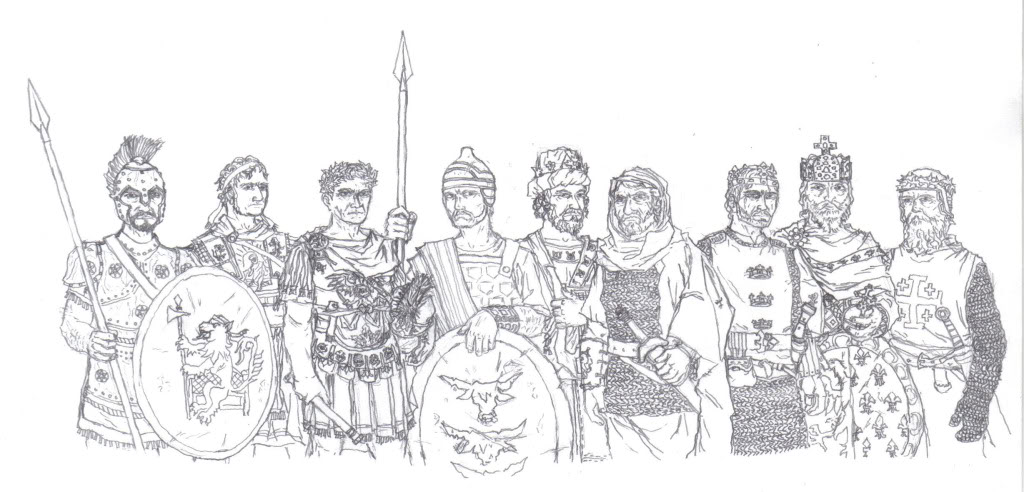
Stirling Castle -2006 - Photo Scotiana.com
Mairiuna, here’s an important element for our Scottish studies: Dr Sally Rush, senior lecturer from the History of Art department at Glasgow’s University has found a link between the Nine Worthies and the medallion-shaped Oak profiles adorning the Scottish Stirling Castle King’s Presence Chamber!

King Presence Chamber - Stirling Castle - Oak Heads Ceiling
Dr Rush has dug deep into arts, crafts, fashions, politics and iconography of Renaissance Europe to gather evidence about the heads – like a detective opening a 450-year-old case. And in some cases the clues are very subtle, for example a flower in the hands of a woman showed she was married, and if her hair was down she was a new bride. Source: Historic Scotland.
You may ask : who are the Nine Worthies? Well, they were historical and mythical figures believed to personify the ideal of chivalry.

Oldest known sculptures of the Nine Worthies at the old city hall in Cologne, Germany. Source: Wikipedia
We find them under three distinct categories within their tradition.
Christian: King Arthur, Charlemagne et Godfrey of Bouillon.
Jewish: Joshua, David and Judas Maccabeus.
Pagan: Hector, Alexander the Great and Julius Caesar.

The Nine Worthies : Hector of Troy, Alexander the Great, Julius Caesar, Joshua, David, Judas Maccabeus, Arthur, Charlemagne, and Godfrey of Bouillon (Drawing by Publius- bbs.stardestroyer.net)
Wikipedia defines the Nine Worthies as a group representing all facets of the perfect warrior.
All, with the exception of Hector and arguably Arthur, are conquering heroes. Most came from royal families. All brought glory and honor to their nations and were noted for their personal prowess in arms. As individuals, each displayed some outstanding quality of chivalry, which, in combination with their historical context, made them exemplars of knighthood. Source: Wikipedia
The link?
Read carefully….
Dr Sally Rush discovered a sketch by German printmaker in woodcut, Hans Burgkmair, (1473-1531) depicting Roman Emperor Caesar that resembles one of the 33 remaining Stirling Castle’s Oak Head carvings.

Researchers believe Julius Caesar is one of the starring figures. Pic © Crown
View more of the oak heads medallions series
Rush said that the presence of Caesar made it “very likely” that all Nine Worthies were represented:
“We are a long way forward in sorting out the identities of the Stirling Heads, separating the real-life people – recognisable figures in the court – from the fictional.
“In this kind of iconographical programme you might expect the inclusion of the Nine Worthies – great military heroes of the past, connected with ideas of chivalry and virtue.
“The inclusion of the Nine Worthies would have made the palace ceiling a hall of fame.
(…)
The historian’s breakthrough came after she studied portraits made at the same time as the carvings.
She said: “My belief was that the king would not sit in front of a carver and pose for him, but that the carver was given an image of James to work to. This process would have been applied for all the heads.”
However, Rush said there was a strong likelihood that many of these drawings have been lost.
She added: “But there is a contemporary image, by Burgkmair, showing three of the Nine Worthies, including Julius Caesar.
“This image of Caesar is very close to a Stirling Head previously thought to be the god Apollo”.
Source: Scotland On Sunday

Master Carver John Donaldson
A replica set is under construction by master crafter John Donaldson and researchers are trying to identify the figures.
Mr Donaldson’s copies of the Stirling heads will decorate the ceiling of the presence chamber — described in its own day as “the most sumptuous room in Europe” — when it reopens to the public in 2011, as part of a £12 million refurbishment project undertaken by Historic Scotland. The original heads will be on display in a new gallery in the castle.
To read more on this subject, click on the following PDF links published by Historic Scotland:
Surviving Originals and New Versions
Talk soon !


[…] Nine Worthies: https://www.scotiana.com/the-nine-worthies-on-the-oak-heads-medallions-at-stirling-castle/ […]
[…] Nine Worthies: https://www.scotiana.com/the-nine-worthies-on-the-oak-heads-medallions-at-stirling-castle/ […]